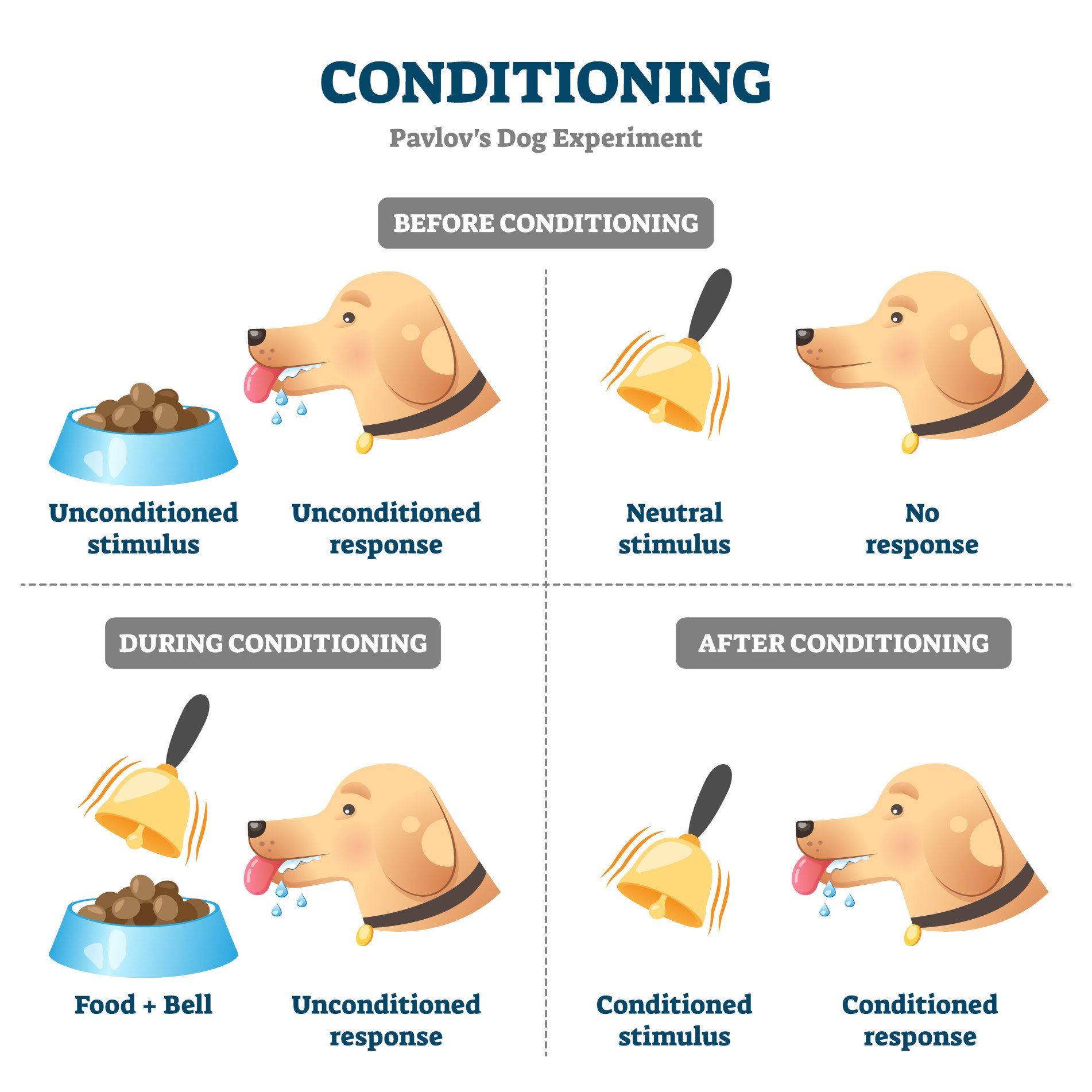Using the terminology of the classical conditioning paradigm, the conditioned stimulus (CS) is a learned stimulus that can eventually trigger a conditioned response. For example, the sound of a bell is the conditioned stimulus in Pavlov’s experiment, and the dogs salivating would be the conditioned response.
In classical conditioning, a person or animal learns to associate the conditioned stimulus (previously a neutral stimulus) with the unconditioned stimulus that naturally produces an automatic behavior (the unconditioned response).
Therefore, a conditioned stimulus makes an organism react to something because it is associated with something else, which is usually a reflective stimuli eliciting an automatic response.
The best-known and most thorough work on classical conditioning was discovered by Ivan Pavlov in the early 1900s in his experiments on the digestive response of dogs. Pavlov had such a great impact on the study of classical conditioning that it is often referred to as Pavlovian conditioning.

In classical conditioning, the conditioned stimulus begins as a neutral stimulus that eventually comes to automatically trigger a conditioned response after becoming associated with an unconditioned stimulus. After the neutral stimulus becomes associated with the unconditioned stimulus, it becomes the conditioned stimulus.
So, if you pair a neutral stimulus (NS) with an unconditioned stimulus (US) that already triggers an unconditioned response (UR) that neutral stimulus will become a conditioned stimulus (CS), triggering a conditioned response (CR) similar to the original unconditioned response.
For example, let’s say you experience horrible food poisoning the first time you eat sushi. While sushi was originally a neutral stimulus, it becomes a conditioned stimulus through its association with being sick (the unconditioned stimulus). As a result, you might begin to feel sick from just the smell of sushi or the sight of raw fish.
What is an example of a conditioned stimulus?
Pavlovs Dogs Experiment
Ivan Pavlov was the first person to discover the process of classical conditioning. When conducting research on the digestion of dogs, Pavlov noticed that the dogs’ physical reactions to food changed over time.
While at first, the dogs would only salivate when the food was placed in front of them, they eventually began to salivate slightly before their food arrived.
He realized that the dogs were not salivating to the smell or sight of the food in front of them but rather the noises and sites that were consistently present before the food even arrived.
To test his theory further, Pavlov would ring a bell shortly before presenting food to the dogs. At first, this elicited no response from the dogs, but eventually, the dogs learned to associate the sound of the bell with the presentation of the food and they would begin to salivate at the sound of the bell alone.
As mentioned earlier, a conditioned stimulus is a stimulus that can eventually trigger a conditioned response.
In this example, the sound of the bell became the conditioned stimulus that triggered the conditioned response of salivation. It is important to note that the neutral stimulus becomes the conditioned stimulus.
Little Albert (Watson & Raynor) Experiment
Behaviorist John B. Watson and graduate student Rosalie Rayner were the first psychologists to apply the principles of classical conditioning to human behavior by showing that emotional reactions could be classically conditioned in people.
Their experiment, known as the case of Little Albert, involved conditioning a phobia in an emotionally stable child.
When Albert was just 9 months old, Watson and Rayner exposed him to a series of stimuli including a white rat, burning newspapers, a monkey, and masks.
At first, Alert showed no fear of any of the stimuli.
However, the next time Albert was exposed to each stimuli, Watson would make a loud noise by hitting a metal pipe with a hammer.
After repeatedly pairing one of the stimuli, the white rat for example, with the loud noise, Albert would begin to expect a loud noise whenever he saw the white rate.
Eventually, Albert would begin to cry from simply seeing the rat. In other words, he was classically conditioned to experience fear at the sight of the rat.
In this example, the white rat began as a neutral stimulus, but it eventually became the conditioned stimulus after repeatedly being paired with the loud noise (the unconditioned stimulus).
Advertising
Classical conditioning is an effective tool in marketing and advertising. The idea is to create an advertisement that has positive features such as catchy music, bright colors, cute babies, attractive models, or funny spokespeople so that the ad will create an enjoyable response in the person exposed to it.
Thus, when the consumer sees the particular product online or in the store, he/she should experience this positive feeling and be more likely to purchase the product.
In this example, the advertisement serves as the unconditioned stimulus (US), and the enjoyment from watching the advertisement serves as the unconditioned response (UR).
Because the product being advertised is mentioned in the advertisement, it becomes associated with the US, and then becomes the conditioned stimulus (CS).
For example, in one study, Gorn (1982) showed research participants pictures of different writing pens of different colors, but paired one of the pens with pleasant music and the other with unpleasant music. When given a choice as a free gift, more people chose the pen color associated with the pleasant music.
FAQs
1. What is a conditioned stimulus?
In classical conditioning, a conditioned stimulus is a previously neutral stimulus that, after being repeatedly associated with an unconditioned stimulus, evokes a conditioned response.
2. Is fear a conditioned response?
Yes, fear can be a conditioned response. Fear conditioning is a behavioral paradigm where organisms learn to predict aversive events or fear new stimuli.
This can be done by pairing a neutral stimulus (e.g., a tone) with an aversive stimulus (e.g. an electrical shock). Eventually, the neutral stimulus alone would be able to elicit the state of fear.
3. What is the difference between the conditioned stimulus and the unconditioned stimulus?
The conditioned stimulus begins as a neutral stimulus that eventually comes to automatically trigger a conditioned response after becoming associated with an unconditioned stimulus.
While a conditioned stimulus produces a learned response to the previously neutral stimulus, the unconditioned stimulus naturally and automatically triggers a response without any previous learning. There is no necessity to learn to respond to an unconditioned stimulus.
4. What is the difference between the conditioned stimulus and the neutral stimulus?
A neutral stimulus is a stimulus that does not produce an automatic response. But, in classical conditioning, the neutral stimulus will become a conditioned stimulus when consistently paired with an unconditioned stimulus.
For example, in Pavlov’s experiment, the sound of the bell began as a neutral stimulus but eventually became the conditioned stimulus that triggered the conditioned response of salivation.
5. How does a neutral stimulus become a conditioned stimulus?
A neutral stimulus becomes a conditioned stimulus when used together with an unconditioned stimulus.
With repeated exposures to both the neutral stimulus and the unconditioned stimulus at the same time, the neutral stimulus will begin to elicit a response known as a conditioned response.
Once the neutral stimulus elicits this conditioned response, the neutral stimulus becomes known as a conditioned stimulus.
6. What is the difference between the conditioned stimulus and the discriminative stimulus?
A discriminative stimulus refers to something, like a person or an event, that precedes a behavioral response. So, the discriminative stimulus comes first and then, the behavior follows as a direct result of this stimulus.
A conditioned stimulus, on the other hand, produces the response, while the discriminative stimulus signals the opportunity to respond.
For example, if a bell tone were the conditioned stimulus, discrimination would involve being able to tell the difference between the bell sound and other similar sounds. Or, in advertising, the packaging on a certain brand of snack cookies might help buyers discriminate between multiple similar products.
7. Is generalization a conditioned response?
Yes, generalization can be a conditioned response. In classical conditioning, stimulus generalization is the tendency for the conditioned stimulus to evoke similar responses after the response has been conditioned.
Once a person or animal has been trained to respond to a stimulus, very similar stimuli may produce the same response as well.
The Little Albert experiment described above is an example of stimulus generalization. In this experiment, Little Albert was conditioned to fear a white rat. He thus continued to exhibit a fear of objects similar to the white rat, such as a dog, rabbit, fur coat, and a white Santa Claus beard.
References
Clark, R. E. (2004). The classical origins of Pavlov’s conditioning. Integrative Physiological & Behavioral Science, 39 (4), 279-294.
Gorn, G. J. (1982). The effects of music in advertising on choice behavior: A classical conditioning approach. Journal of marketing, 46 (1), 94-101.
Harris, B. (1979). Whatever happened to little Albert?. American psychologist, 34 (2), 151.
Hawkins, D., Best, R., & Coney, K. (1998.) Consumer Behavior: Building Marketing Strategy (7th ed.). Boston, MA: McGraw-Hill.
Pavlov, I. P. (1897/1902). The work of the digestive glands. London: Griffin.
Pavlov, I. P. (1928). Lectures on conditioned reflexes. (Translated by W.H. Gantt) London: Allen and Unwin.
Pavlov, I. P. (1927). Conditioned Reflexes: An Investigation of the Physiological Activity of the Cerebral Cortex. Translated and edited by Anrep, GV (Oxford University Press, London, 1927).
Pavlov, I. P. (1955). Selected works. Moscow: Foreign Languages Publishing House.
Watson, J.B. (1913). Psychology as the behaviorist Views It. Psychological Review, 20, 158-177.
Watson, J. B., & Rayner, R. (1920). Conditioned emotional reactions. Journal of experimental psychology, 3 (1), 1.

